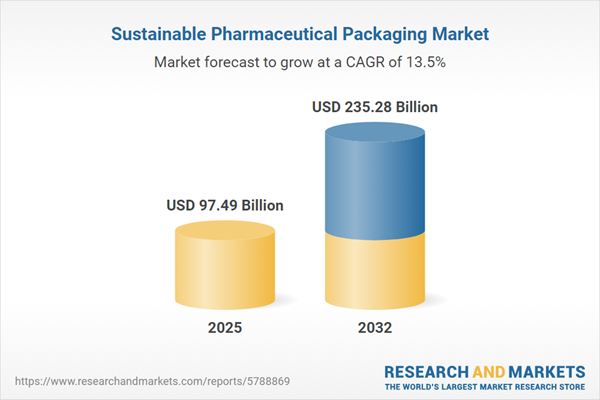Speak directly to the analyst to clarify any post sales queries you may have.
The sustainable pharmaceutical packaging market is undergoing rapid transformation, integrating advanced eco-friendly materials and design to meet industry, regulatory, and stakeholder expectations. Senior decision-makers prioritizing resilience and compliance will find this report essential for navigating a complex, evolving sector driven by sustainability imperatives.
Market Snapshot: Sustainable Pharmaceutical Packaging Market Growth
The sustainable pharmaceutical packaging market grew from USD 85.70 billion in 2024 to USD 97.49 billion in 2025. Continued growth is anticipated at a CAGR of 13.45%, with the market projected to reach USD 235.28 billion by 2032. Environmental mandates, supply chain considerations, and increased stakeholder engagement are fueling the adoption of new materials and practices across the sector.
Scope & Segmentation
- Packaging Types: Ampoules, blister packs, bottles, pouches, and vials cover a variety of pharmaceutical product forms, each offering differing barrier properties, reusability, and recyclability.
- Material Types: Biodegradable plastics including PHA, PLA, and starch-based polymers; glass variants such as borosilicate, flint, and soda lime; metal options like aluminum and steel; paper-based corrugated board and kraft paper.
- Drug Types: Liquid dosages (solutions, suspensions), semi-solid forms (creams, gels, ointments), and solid dosages (capsules, tablets) highlight the diverse functional requirements for packaging solutions.
- End Users: Hospitals, clinics, research laboratories, online pharmacies, and retail pharmacies each impose specific handling, safety, and compliance considerations.
- Technologies: Active packaging (ethylene and oxygen scavengers), intelligent packaging (NFC, QR code, RFID), modified atmosphere packaging (MAP containers and films), and vacuum packaging (lidding films, vacuum pouches) enhance traceability, shelf life, and product safety.
- Regional Coverage: Americas (United States, Canada, Mexico, Brazil, Argentina, Chile, Colombia, Peru), Europe (United Kingdom, Germany, France, Russia, Italy, Spain, Netherlands, Sweden, Poland, Switzerland), Middle East (UAE, Saudi Arabia, Qatar, Turkey, Israel), Africa (South Africa, Nigeria, Egypt, Kenya), Asia-Pacific (China, India, Japan, Australia, South Korea, Indonesia, Thailand, Malaysia, Singapore, Taiwan).
- Competitive Landscape: Major players include Amcor plc, Berry Global Group, Mondi plc, Gerresheimer AG, West Pharmaceutical Services, AptarGroup, SCHOTT AG, Constantia Flexibles, Tekni-Plex, and ALPLA Werke.
Sustainable Pharmaceutical Packaging: Key Takeaways
- Integrating eco-friendly and recycled materials is now a strategic imperative for pharmaceutical companies, driven by both regulatory demands and consumer preference shifts.
- Collaboration with chemical and packaging material suppliers is accelerating the introduction of next-generation biodegradable coatings and enhanced material properties.
- Innovation centers are streamlining the development-to-market cycle for sustainable packaging formats, ensuring compliance and accelerating large-scale adoption.
- Investment in digital solutions—like RFID, QR codes, and NFC—supports real-time monitoring for enhanced transparency, traceability, and product security.
- Closed-loop recycling partnerships and life-cycle analysis within value chains are central to reducing waste and supporting supply chain circularity, especially as industry leaders set benchmarks in this arena.
- Adaptive regional strategies ensure that market entrants can respond effectively to unique regulatory, infrastructure, and stakeholder priorities across global markets.
Tariff Impact: U.S. Policy and Global Supply Chain Adjustments
With tariffs set to be implemented by the United States from early 2025 targeting glass, plastics, and metals, manufacturers are proactively diversifying suppliers and exploring near-shoring solutions. These measures have led to shifts in inventory strategy and rising transportation costs, making advanced analytics and supply chain agility vital for cost containment and resilience. Understanding tariff implications will be essential for sustainable sourcing and operational continuity.
Methodology & Data Sources
Findings in the sustainable pharmaceutical packaging market report are built on primary interviews with senior executives, thorough secondary research, and validation through stakeholder workshops. Rigorous data triangulation ensures accuracy and insight relevance across functional and geographic areas.
Sustainable Pharmaceutical Packaging Market: Why This Report Matters
- Enables informed strategic planning by highlighting actionable opportunities in technology, material innovation, and global supply chains.
- Offers clarity on evolving regional regulations, competitive dynamics, and the critical role of recycling and circularity in value creation.
- Empowers leaders to anticipate shifts in stakeholder expectations, facilitating compliance and reinforcing differentiation through sustainability-led initiatives.
Conclusion
Collaborative innovation, regulatory alignment, and data-driven decision-making are fundamental for success in the evolving sustainable pharmaceutical packaging market. Adoption of advanced materials and digital technologies empowers organizations to drive both operational excellence and sustained environmental outcomes.
Additional Product Information:
- Purchase of this report includes 1 year online access with quarterly updates.
- This report can be updated on request. Please contact our Customer Experience team using the Ask a Question widget on our website.
Table of Contents
3. Executive Summary
4. Market Overview
7. Cumulative Impact of Artificial Intelligence 2025
Companies Mentioned
The companies profiled in this Sustainable Pharmaceutical Packaging market report include:- Amcor plc
- Berry Global Group, Inc.
- Mondi plc
- Gerresheimer AG
- West Pharmaceutical Services, Inc.
- AptarGroup, Inc.
- SCHOTT AG
- Constantia Flexibles Group GmbH
- Tekni-Plex, Inc.
- ALPLA Werke Alwin Lehner GmbH & Co KG
Table Information
| Report Attribute | Details |
|---|---|
| No. of Pages | 183 |
| Published | November 2025 |
| Forecast Period | 2025 - 2032 |
| Estimated Market Value ( USD | $ 97.49 Billion |
| Forecasted Market Value ( USD | $ 235.28 Billion |
| Compound Annual Growth Rate | 13.4% |
| Regions Covered | Global |
| No. of Companies Mentioned | 11 |









